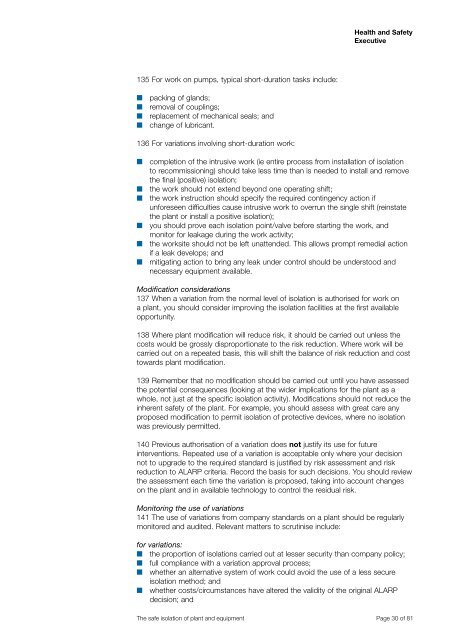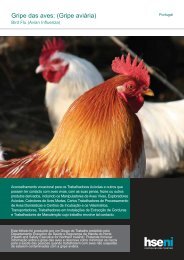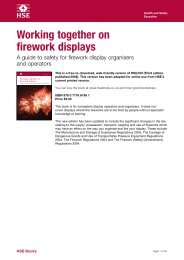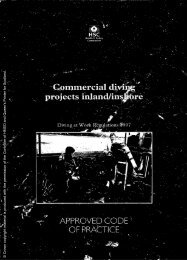The safe isolation of plant and equipment (HSG253) - Health and ...
The safe isolation of plant and equipment (HSG253) - Health and ...
The safe isolation of plant and equipment (HSG253) - Health and ...
You also want an ePaper? Increase the reach of your titles
YUMPU automatically turns print PDFs into web optimized ePapers that Google loves.
135 For work on pumps, typical short-duration tasks include:<br />
■<br />
■<br />
■<br />
■<br />
packing <strong>of</strong> gl<strong>and</strong>s;<br />
removal <strong>of</strong> couplings;<br />
replacement <strong>of</strong> mechanical seals; <strong>and</strong><br />
change <strong>of</strong> lubricant.<br />
136 For variations involving short-duration work:<br />
■<br />
■<br />
■<br />
■<br />
■<br />
■<br />
<strong>Health</strong> <strong>and</strong> Safety<br />
Executive<br />
completion <strong>of</strong> the intrusive work (ie entire process from installation <strong>of</strong> <strong>isolation</strong><br />
to recommissioning) should take less time than is needed to install <strong>and</strong> remove<br />
the final (positive) <strong>isolation</strong>;<br />
the work should not extend beyond one operating shift;<br />
the work instruction should specify the required contingency action if<br />
unforeseen difficulties cause intrusive work to overrun the single shift (reinstate<br />
the <strong>plant</strong> or install a positive <strong>isolation</strong>);<br />
you should prove each <strong>isolation</strong> point/valve before starting the work, <strong>and</strong><br />
monitor for leakage during the work activity;<br />
the worksite should not be left unattended. This allows prompt remedial action<br />
if a leak develops; <strong>and</strong><br />
mitigating action to bring any leak under control should be understood <strong>and</strong><br />
necessary <strong>equipment</strong> available.<br />
Modification considerations<br />
137 When a variation from the normal level <strong>of</strong> <strong>isolation</strong> is authorised for work on<br />
a <strong>plant</strong>, you should consider improving the <strong>isolation</strong> facilities at the first available<br />
opportunity.<br />
138 Where <strong>plant</strong> modification will reduce risk, it should be carried out unless the<br />
costs would be grossly disproportionate to the risk reduction. Where work will be<br />
carried out on a repeated basis, this will shift the balance <strong>of</strong> risk reduction <strong>and</strong> cost<br />
towards <strong>plant</strong> modification.<br />
139 Remember that no modification should be carried out until you have assessed<br />
the potential consequences (looking at the wider implications for the <strong>plant</strong> as a<br />
whole, not just at the specific <strong>isolation</strong> activity). Modifications should not reduce the<br />
inherent <strong>safe</strong>ty <strong>of</strong> the <strong>plant</strong>. For example, you should assess with great care any<br />
proposed modification to permit <strong>isolation</strong> <strong>of</strong> protective devices, where no <strong>isolation</strong><br />
was previously permitted.<br />
140 Previous authorisation <strong>of</strong> a variation does not justify its use for future<br />
interventions. Repeated use <strong>of</strong> a variation is acceptable only where your decision<br />
not to upgrade to the required st<strong>and</strong>ard is justified by risk assessment <strong>and</strong> risk<br />
reduction to ALARP criteria. Record the basis for such decisions. You should review<br />
the assessment each time the variation is proposed, taking into account changes<br />
on the <strong>plant</strong> <strong>and</strong> in available technology to control the residual risk.<br />
Monitoring the use <strong>of</strong> variations<br />
141 <strong>The</strong> use <strong>of</strong> variations from company st<strong>and</strong>ards on a <strong>plant</strong> should be regularly<br />
monitored <strong>and</strong> audited. Relevant matters to scrutinise include:<br />
for variations:<br />
■ the proportion <strong>of</strong> <strong>isolation</strong>s carried out at lesser security than company policy;<br />
■ full compliance with a variation approval process;<br />
■ whether an alternative system <strong>of</strong> work could avoid the use <strong>of</strong> a less secure<br />
<strong>isolation</strong> method; <strong>and</strong><br />
■ whether costs/circumstances have altered the validity <strong>of</strong> the original ALARP<br />
decision; <strong>and</strong><br />
<strong>The</strong> <strong>safe</strong> <strong>isolation</strong> <strong>of</strong> <strong>plant</strong> <strong>and</strong> <strong>equipment</strong> Page 30 <strong>of</strong> 81







